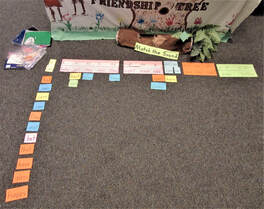 Students can arrange words matched to their vowel sounds.
Students can arrange words matched to their vowel sounds. If you do not test, you will have no idea whether your tutoring techniques are working or not. But let us look at the way you test, which is just as important.
Do you just test at the student’s grade level?
I work with at-risk students. Some of my students have failed in school for two or more years. Others are struggling and just need a different teaching method. Therefore, I cannot simply say, “Oh, you are a 4th grader; therefore, I will give you the 4th grade test. I use a testing procedure that allows each and every student to work up to their ability.
That is, I use a step system so that students’ can progress up to their reading level. I have had 1st graders who could read at the third grade level but had zero comprehension. I have had 4th graders who could not read at the pre-kindergarten level. Therefore, just giving a student their grade level test will not work.
So, when I give the pre-test, all students start at step one, regardless of whether they are 1st, 3rd, 5th, or 6th graders. My test packet enables me to accurately identify the student's reading level and reading problems.
Students “capture” the words that they are struggling with. I use the word “capture:” instead of saying the student missed 10 words, I say the student captured 10 words that we want to work on. Yes, the students know they missed the word, but they really like saying they captured it more than saying they missed it. Then, we proceed to work on the captured words.
Should students be tested at the end of each tutoring session?
I also like to check at the end of each tutoring session to make sure that the student understood what I taught for that day.
Don't give pop quizzes. Everyone hates pop quizzes.
Since vowel clustering is my teaching method, I use a vowel board to summarize, test, and reteach at the end of each session to make sure the student understood what I taught for that particular day. I try to turn my testing into a game with the vowel board, but testing is very important. Testing can tell you whether your student is ready to go to the next lesson or whether you need to go back and reteach the lesson again. Let’s look at a preview from my new tutoring book. Look at this from page 87:
******************

She was a fourth-grader when she was sent to my Reading Orienteering Club program. She breezed through the Level 1 and Level 2 words for the letter a. She struggled but managed to learn Level 1 and Level 2 words for the letter e. When we started studying letter i, she was lost.
I was surprised. Most students find letter i words to be easier than letter e words. It was the long vowel sound for letter i that gave her the most trouble. There are both y and i letter combinations that use the long vowel sound for letter i, but most students find these combinations fairly easy to learn.
After working with the student, I discovered that she was still trying to sound all words out letter-by-letter. As I explained to her, “yes, we want to sound out words letter-by-letter-- whenever possible. I used the vowel center gameboard to show several times that we could not sound out each individual letter: height, sigh, sight, feisty, eye. I always like to work with only five words at a time. I first reminded her that sometimes both consonants and vowels can work as a silent letter or combine to make a totally new sound.
We looked at our five words. We circled each silent letter. Secondly, I reminded her that we had learned that some letters combine to make a new sound. I pulled out words from letter a and e previously studied. I selected words that use letter combinations to make a new sound: that, black, cheese, eight, earth. These were words that she had already studied and learned.
Again, we circled any silent letters. Then, we drew a line under letters that combined to make a new sound: th, ck, ch, eigh, ear, th. I was using a re-teaching technique. I went back to words she was familiar with to reteach the concept of combining letters to make a new sound.
Then, I returned to the five letter i words that combine letters to make a new sound: height, sigh, sight, feisty, eye. I repeated the process. We circled silent letters. We underlined letters that combined to make a new sound. When the student wasn’t sure, we turned to the dictionary.
By using this reteaching technique, the student began to understand that not every word can be broken down letter-by-letter. As I explained to her, “we must include pronunciation of sound clusters to our goal of letter-by-letter pronunciation. We must remember that when we have a sound cluster, it’s a new sound. The letter no longer represents a single letter sound when it is in a cluster. Clusters can be vowel clusters or consonant clusters.
We practiced. I used both the Build-by-Sound (page 106) reteaching technique and the Take Away - Make New technique (page 107). Finally, she began to understand.
When she truly understood, she mastered letter i. Sometimes, we think that a child understands, but in reality, they do not. Therefore, we must go back and review, reteach, and practice until the student truly understands.
**********************
My new tutoring book Why Can't We Teach Children to Read? Oh, but Wait We Can, helps you see how to test and reteach when necessary. I provide step-by-step instructions so that you will know when your student is ready to go to the next step. So, yes, you need to have a method of testing at the end of each tutoring session, but you do not want to use a written quiz or worksheet. Be creative.
Next time, we are talking about motivation: When tutoring, is intrinsic motivation better than extrinsic? Stay tuned.
For more on using vowel clustering, read: Vowel Clustering Teaches Children to Build Words: Phonics Does Not6/8/2019
If you’d like a longer preview from the book, click here.
If you have questions or need help in tutoring, please contact me. I’m always happy to help.
 RSS Feed
RSS Feed
